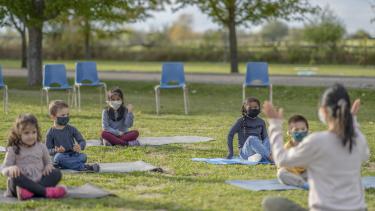
Outside & Online
As we navigate the fourth wave of the pandemic, with an eye to post-pandemic teaching and learning, it has dawned on me that two of the lessons learned from the pandemic might be at odds with each other. With physical distancing being one of the best ways to keep ourselves and kids safe from COVID-19, we saw many classrooms migrate outdoors, at least for part of their instructional experience. This was sage advice given to us by public health, and many classroom teachers were all over it. Some started with simple brain and body breaks, and others actively embraced a walking curriculum and used “place” to guide their outdoor inquiry. I observed this when I visited Matsqui Elementary last year. Staff members were at various stages of inquiry about outdoor learning, but certainly among the key benefits were the natural connection to our core competencies and the positive impact this had on student and staff wellbeing.
Of course, this was not new for long-time outdoor enthusiasts. Teachers who are passionate about learning and living outdoors have engaged their students in this kind of learning for years. They know first-hand of the physical and emotional benefits of learning outdoors. Some of you may know about our nature kindergarten programs where the outdoor is the critical feature of their learning experiences. Nonetheless, it is delightful to now see so many of our classrooms spending more time outdoors. In the weeks and months ahead, as the pandemic conditions hopefully wane, it is my sincere hope that we see more and more of our students learning away from the walls of their classrooms. Indeed, this is one of the lessons I hope we all take away with us as we move forward.
The second lesson, which on the surface might seem to confound the first, relates to more ubiquitous access to technology and blended learning. Many of us will remember in the spring of 2019 when face-to-face instruction was put on hold for several months. Panic set in as we desperately tried to pivot by providing devices to students as we quickly learned how to engage our students that we could no longer have in our physical presence. Again, some teachers flourished in this environment, and others struggled to create meaningful learning opportunities for students under the most trying circumstances. In the end, we got through it, and while it was not perfect by any means, we developed some new capabilities. All of us learned a little bit more about these devices that sit on our desks. We each mastered at least one new skill to take with us going forward.
However, one of the key takeaways was that virtual learning (for the most part) pales in comparison to face-to-face learning for human connection and instructional practice. In addition, most of us are still concerned about the impact of excessive screen time on the developing brains of our students and consequently are reluctant to fully embrace online learning. While we certainly want to avail our students of these various technologies, we must temper it with a “just right” approach.
So how might we square this paradox of providing more outdoor learning and at the same time meaningfully integrate technology to enhance student learning? How do we get kids to embrace the socioemotional benefits of outdoor learning and at the same time provide them with the life skills to authentically use technology to solve problems? They are not mutually exclusive positions. I have observed a very skillful integration of both perspectives in some of our schools and am interested to learn about places where we are doing both well. In my travels to schools this year it will be something I will attend to, as I am certain there are breakthrough practices in both these spaces from which we can all learn.
Stay tuned…